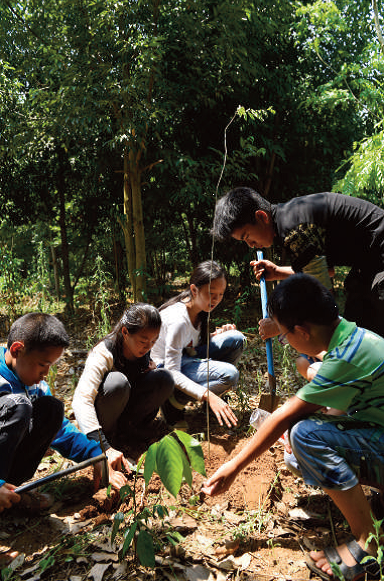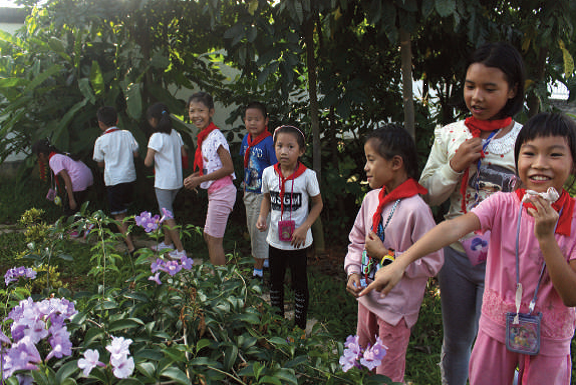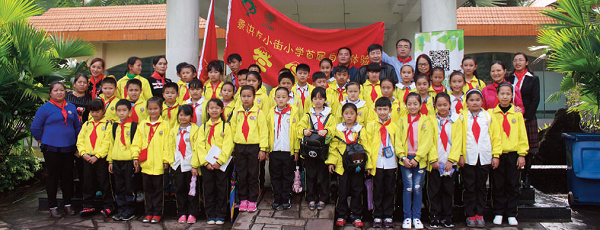The school garden project was started in 2014 and finished in 2016, as an environmental education component of Xishuangbanna Tropical Botanical Garden’s (XTBG) Zero Extinction project. XTBG helped design and build the garden throughout the two years. Afterwards, XTBG has also been assisting in organizing the school’s environmental education activities in the school garden, and in getting students involved in a project that aims to reforest the Holy Hill, which is culturally significant to the Dai People, a local ethnic group.
BACKGROUND
Xishuangbanna, in tropical southwest China, supports more than 10% of China’s total vascular plant flora in 0.2% of the land area. Rapid expansion of cash crops in recent decades has reduced the forest cover in many areas to scattered fragments. Some natural tropical rainforest remnants are conserved on the Holy Hills, as called by the Dai people, of local villages. One of these Holy Hills is near Manyangguan village. Its forest remnant was part of a larger forest area until the 1950s. Although the remnant is considered to be a Holy Hill by the local Dai people, it has been gradually reduced to 13.85 ha. The forest has also been degraded by cutting of timber and other plants.
The remnant was floristically inventoried in 1959/1960, 1997 and 2008. Although the forest area has shrunk, the number of species in the remnant has remained similar. However, the number, reduced by the loss of many shade-tolerant primary forest species, has been compensated by the addition of pioneers and ruderal species, including several aliens. The structural changes since the first survey are also dramatic, with the loss of most large trees, creating many gaps in the canopy. The remnant is now almost completely surrounded by rubber monocultures, but local Dai villagers’ respect for their Holy Hill and the remnant’s historical and scientific importance has ensured that a core area remains more or less intact.
In 2013, under the financial support of BGCI, XTBG partnered with the Management Bureau of Xishuangbanna National Nature Reserve (XNNR), Jinghong Forest Station and Manyangguan primary school for a project that includes a new vascular flora survey, forest restoration and public education. This article will focus on education and restoration aspects, both of which are reflected in a school garden project in Manyangguan primary school.

Manyangguang primary school students planting
trees on the Holy Hill (by Duan Qiwu)
SCHOOL GARDEN PROJECT
In 2014, XTBG started a school garden project in Manyangguan primary school, as an environmental education component of its Zero Extinction project. The primary school was founded in 1958. The majority of its students are from nearby ethnic groups, including Dai, Hani, Lahu, Bulang and some international students from Myanmar. XTBG helped design and build the garden over two years, while ensuring the involvement of the school’s students, e.g. they drew out their vision and preferred design and layout for the garden. Building of the school garden project was completed in 2016. The garden covers an area of 700m2, consisting of four collections:

Manyangguang primary school students presenting
the plants in their school garden. “Those purple flowers
smell like garlic”, they said. (By Qiu Wnnhui)
1) plants for forest restoration, including large tree species and shade-tolerant species; 2) plants relevant to ethnic culture, e.g. food, medicine and religion; 3) lianas, 4) other plants, with a focus on those that have distinct adaptation skills in the tropical environment, in order to stimulate students’ curiosity of further exploration in ecology.
While the garden was finished in 2016, educational activities in and relevant to the garden are on-going. Within the activities XTBG’s environmental educators help the school organize, there has been a focus on plants that are culturally important to local ethnic groups, and on plants that are used for forest restoration in the rainforest remnant where the Holy Hill is located.
Students not only use a sensory approach to get to know the plants, they also learn how to grow them from seed and cuttings and are guided to understand the deeper meaning of the plants in terms of ethnobotany. It is crucial that the younger generation, by recognizing plants’ significance in their culture, by learning to take care of their school garden, and by establishing personal connections with plants and earth, understand the deep rooted relationship between plants and their cultural heritage. Realizing the impact on their environment and cultures brought by cash crops like rubber trees and bananas, which have dominated the landscape they are now familiar with but which is now extremely different from what their parents and grandparents used to see and live in.
For the forest restoration aspect, XTBG and Manyangguang primary school co-organize educational activities for students to learn about iconic species for their local rainforest, including the large trees that disappeared in the Holy Hill forest remnant. The activities began with students’ assistance in setting up interpretation signs and hanging species IDs for the young plants in their school garden, followed by observation and keeping journals about the plants in the garden. Then, the school organized for the students to visit XTBG, where tall and large tropical trees are well conserved, and where the students can see what the young trees in their garden may look like one day. Next, guided by a local Dai ranger employed by XTBG to take care of the Holy Hill forest remnant, students visited the Holy Hill, learnt about the dramatic changes happening to the forest in the last few decades and the consequences which are noticeable under the current forest canopy. Finally, XTBG prepared seedlings of local tropical large tree species for the students to plant in the Holy Hill forest remnant, as part of the forest restoration effort.
With multiple parties in collaboration, cultural and ecological aspects in interaction, and different generations in communication, an environmental education model based upon the school garden is taking shape, and will continue to influence local students in (and hopefully beyond) Manyangguang primary school in Xishuangbanna.

Manyangguang primary school students visiting
XTBG, including its ethnic culture museum and
preserved rainforest where tall and large tropical trees
still stand. (By Qiu Wnnhui)



